版权所有:内蒙古大学图书馆 技术提供:维普资讯• 智图
内蒙古自治区呼和浩特市赛罕区大学西街235号 邮编: 010021

作者机构:Max Planck Inst Biochem Dept Mol Struct Biol Klopferspitz 18 D-82152 Martinsried Planegg Germany
出 版 物:《FEBS LETTERS》 (欧洲生化学会联合会快报)
年 卷 期:2020年第594卷第20期
页 面:3243-3261页
核心收录:
学科分类:0710[理学-生物学] 071010[理学-生物化学与分子生物学] 07[理学]
主 题:cellular structural biology correlative light‐ electron microscopy cryo‐ electron tomography image processing workflow sample preparation workflows structural biology in situ
摘 要:Structural biologists have traditionally approached cellular complexity in a reductionist manner in which the cellular molecular components are fractionated and purified before being studied individually. This divide and conquer approach has been highly successful. However, awareness has grown in recent years that biological functions can rarely be attributed to individual macromolecules. Most cellular functions arise from their concerted action, and there is thus a need for methods enabling structural studies performed in situ, ideally in unperturbed cellular environments. Cryo-electron tomography (Cryo-ET) combines the power of 3D molecular-level imaging with the best structural preservation that is physically possible to achieve. Thus, it has a unique potential to reveal the supramolecular architecture or molecular sociology of cells and to discover the unexpected. Here, we review state-of-the-art Cryo-ET workflows, provide examples of biological applications, and discuss what is needed to realize the full potential of Cryo-ET.